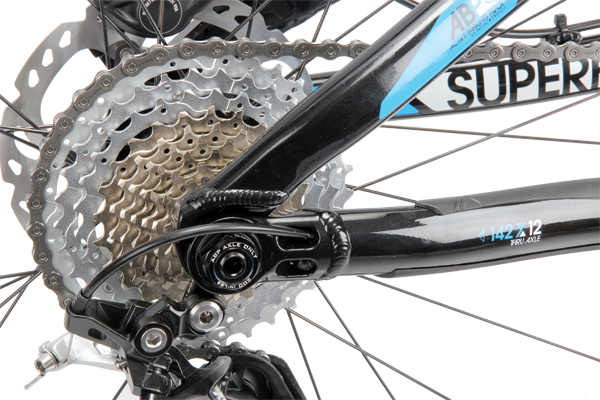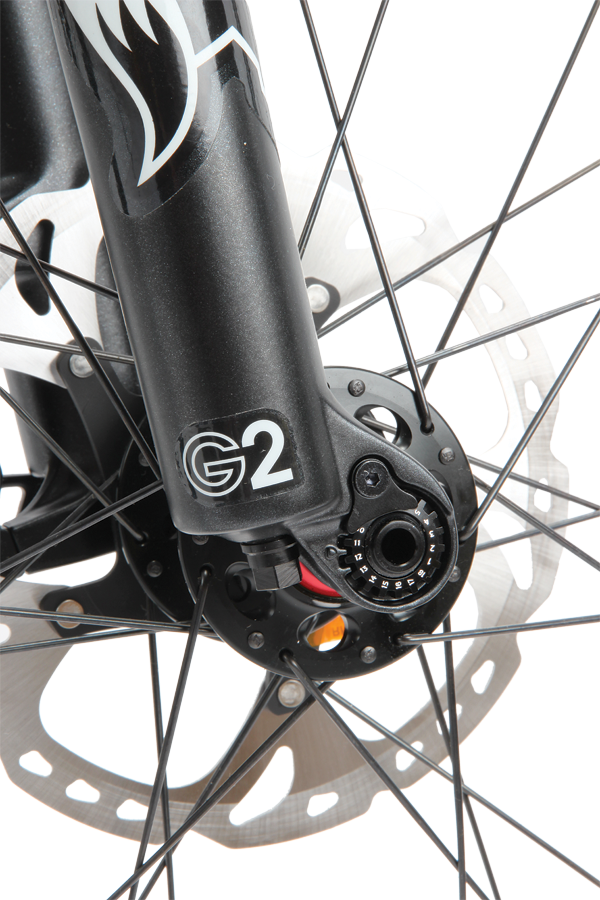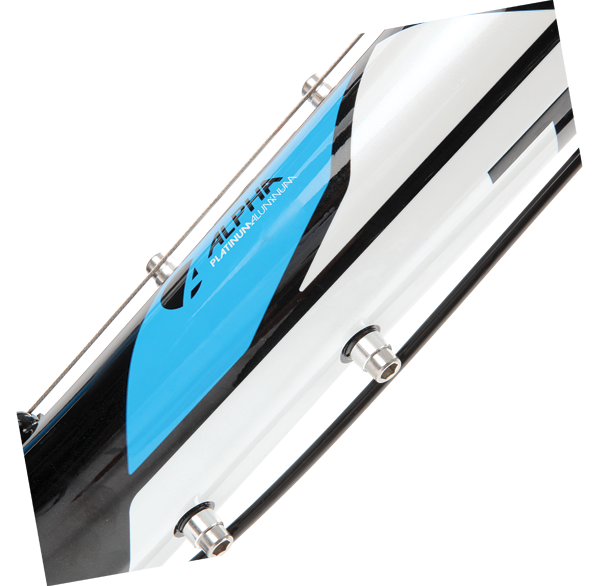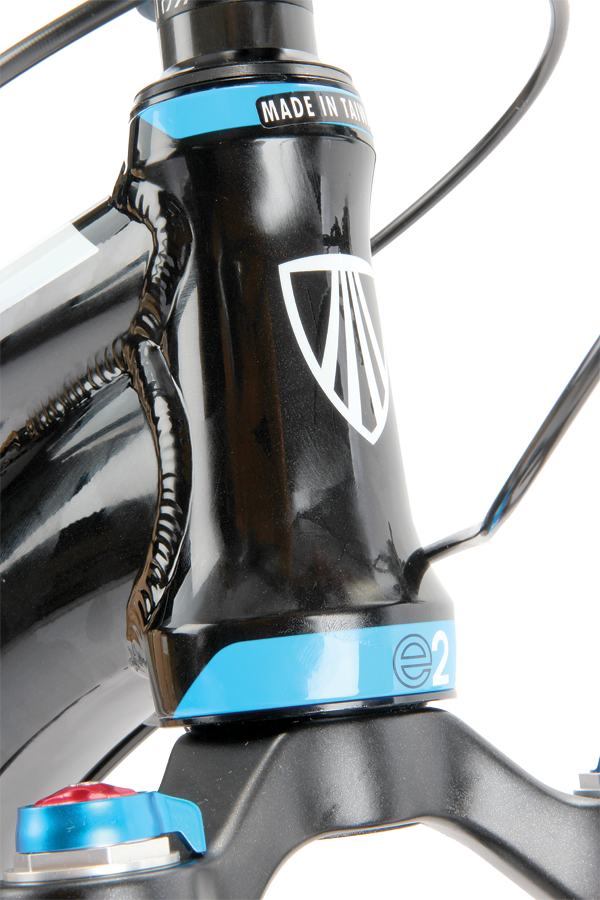The downtube on the Superfly reads ‘Trek’, but the Superfly is the child of mountain bike father figure Gary Fisher. Look further at the decals and you’ll find a ‘Gary Fisher Collection’ on there too. The free spirited Californian pioneer and the vanilla safe Wisconsin bike maker form a fearsome blend of innovation and experimentation combined with mass market R&D and purchasing budgets.
The vital stats on the Superfly 100 are pretty commonplace stuff; alloy frame, 110mm of travel at the back and 100mm up front supported by Fox dampers, and Shimano XT drivetrain and brakes. It’s all durable, functional and offers fantastic trail performance and the price isn’t astronomical. This is the sort of bike that dealers pit brand-against-brand on a daily basis, so to be successful Trek needs to add their own special flavour to the equation.
Visionary Soul
Way back in the day before long-travel trail bikes Gary Fisher came up with one of his best known design concepts; called ‘Genesis Geometry’ it paired a long top tube with a short stem (for the period). This gave the bikes the right cockpit length, a long front centre for descending stability and the short stem kept handling snappy. Fast forward to the present day and this set-up is only just becoming the norm in new-school trail bike design. Mr Fisher is a great thinker and was well ahead of his time with the original Genesis Geometry—not to mention 29-inch wheels, oversized headsets, dual suspension trail bikes with disc brakes and so on…

The Superfly 100 makes use of Fisher’s G2 (Genesis 2) geometry, which uses a fork with more offset to reduce the axle trail. Developed specifically for their 29-inch wheeled bikes it aims to produce responsive steering, without resorting to the use of a particularly steep head angle. Steep head angles are all well and good but they can make you feel like you’re too far over the front during steep descents and lead to a sketchy ride.
With all of Gary’s handling tricks aboard it’s time for Trek to add their goodies to the Superfly basket in the form of the Active Braking Pivot (ABP). This is a Trek developed suspension system that is used on all of their duallies. The ABP design does not pivot on the seat stay or the chainstay but instead pivots around the rear axle, and as the name suggests, it aims to keep the suspension active and neutral when the anchors are on.

The ABP system also adds a small degree of complexity, as the pivot bearing has to allow the wheel axle to pass through its centre (on most bikes the suspension pivot is completely separate from the wheel axle). Trek uses large bearings and some specially made nuts and axles to pull off the ABP system, and in practice the only drawback is that the derailleur hanger is integrated with one of the pivot axles. This means trailside replacement requires an open-ended spanner—I don’t know what multi-tool you ride with, but this spanner is not on it, trust me!
For 2012 Trek has adopted the increasingly popular 142 x 12mm rear axle standard on the Superfly 100. Trek suggests that this change has increased stiffness by 35%. The back end of the Superfly feels extremely solid, whether it’s the thru-axle or something else it doesn’t really matter as it just works. If ever there was a standard made to work with the ABP design is must be this one. The thru-axle has to be removed to take out the wheel, which is also the case with ABP bikes that use a conventional quick release. What would be seen as a hassle with a quick release wheel is simply expected with a 142 x 12mm equipped bike. The axle employed by Trek uses RockShox’s patented Maxle lever which is very simple to use, so there’s no need to worry—if anything it’s easier than a traditional quick release wheel. It’s also worth noting that Trek also offers adaptors for those who have existing 135mm quick release wheels that they may want to use—handy if you’ve already invested in a gun set of race wheels.

This review of the axle standards and compatibility is worthwhile, as prospective owners could well be looking for an upgrade in this department. The Trek ships with Bontrager Race Lite TLR wheels, which Trek have stickered up to perfectly match the graphics on the rest of the bike. They make for a super slick looking final package, but compared to the rest of the bike, the wheels are definitely the weakest link. The Superfly is a capable machine and deserves a set of wheels that are stiffer or lighter, or preferably both, to get the best out of it.

When pushed hard the 28-spoke Race Lites feel springy rather than taut and would surely benefit from a few extra spokes, as 32-spoke wheels tend to produce a much stiffer feel. As it is the Race Lites aren’t particularly svelte (almost 1,900g per pair), so they miss the mark a little on both performance factors. The hubs are decent sealed bearing units and the rims are designed for conversion to tubeless, so these wheels have some really good features. While they didn’t give us any troubles, the Superfly could get a big performance boost from the right wheel upgrade. Pencil it in for a Christmas or birthday perhaps.

Other than Fox and Shimano, everything else bolted to the Superfly is from Trek’s in-house Bontrager brand. The bars are nice and wide, the saddle comfy and not too wide. Of particular mention should be the 29-1 Team tyres, which are light and fast rolling. These tyres give the Superfly a sprightly feel on firm trails and help it glide along with little fuss. They are a great option as race day or marathon tread and are offered aftermarket in case you want to check them out. Although they are marked as a 2.2 size, their volume isn’t all that big and the knobs have a low profile. As a result they get a little out of their depth once the trail surface gets loose, but in the right conditions they’re a comfy pair of shoes.

Comfy Shoes
The overall character of the Superfly 100 is a little like this too; comfy. The carbon version of the Superfly 100 is raced by Trek Factory Team riders in full on XC events, but the Superfly doesn’t feel like a typical race focused machine like many of its competitors. The G2 geometry really does work and the Trek feels incredibly ‘light’ at the handlebars. It doesn’t take extra effort or odd line selection to persuade this bike around squiggly singletrack and at cruising speeds the Trek is a natural. It’s the kind of bike that you can hop on for the first time and feel at home right away. It doesn’t seem to have a particular aggression, feistiness or need for speed, but it will go as fast as you want it to if you can pedal it.

The effortless personality of the Superfly makes it easy to pick up speed as soon as the trail points down. Once up to speed the tapered head tube and thru-axle mounted wheels provide a solid and secure feel, especially over ruts, roots and off-camber trails. The Fox ‘Evolution Series’ Float fork and ‘Performance Series’ RP23 rear shock are not from the top of Fox tree, but it doesn’t seem to matter on the Superfly. The neutral handling attributes of the Superfly make it easy for the rider to stay smooth and this bike is very predictable whether you are going up or down.
Pedalling efficiency was also good and only a subtle amount of platform damping was required to keep the rear end in check. With the RP23 ‘Adaptive Logic’ ProPedal dial open and set to ‘position one’, the Superfly tackles the trails in a solid and efficient manner whilst still tracking the ground and sucking up the bumps. Alternately, you can also set the dial to ‘zero’ for a supple feel and flick the ProPedal lever when you hit a road climb. In any case, the rear end offers an efficient yet comfortable ride that’s well suited to its XC/marathon intentions.

The Shimano XT 2x10 component group is a sensible choice, and for the $3,999 asking price you actually get a near complete group—not just a rear derailleur as is often the case. Only the rear cassette is SLX and that’s not likely to worry anyone too much. On my local trails the 38-tooth large chainring combined with the 11/36 rear cassette was fine for all situations, but I can’t help but think that casual riders who spend the bulk of their time in a traditional 32-tooth middle ring will find the 38 too tough to pedal and the 26-tooth little ring a bit undersized. The Superfly platform is used by Trek’s pro riders and 2x10 makes sense for those superhumans. Much will depend on the nature of your local trails, but I feel that 3x10 might make more sense for the prospective Superfly 100 AL Pro rider—the lower level AL Elite already comes with 3x10.
While the carbon Superfly 100 is reputed as one of the lighter 29er suspension platforms currently on the market, the alloy version is no butterfly. Our 19-inch frame was 2,860g, making it lighter than some of the more trail-oriented offerings but a good half-kilo more than the carbon variant.

All About the Details
There’s nothing skimpy or weight weenie-ish about the Superfly. The frame feels solid and it’s really nicely made with good sized bearings and oversized alloy pivot hardware. The hardware is all laser etched with the correct torque settings, and even the upper shock mounting bolt is a super classy looking custom alloy unit—you’ll have Buckley’s of getting a replacement on a Sunday afternoon, but if you follow the torque specs you shouldn’t have a problem anyway.
The Trek also has excellent cable routing which avoids tight kinks in the shift and brake lines. The rear derailleur cable is extremely cleanly executed and a lovely example; it passes from the top side of the down tube directly into the inside of the chainstay and pops out just above the derailleur. I’d been looking forward to fitting a water bottle on the Superfly as my personal bike doesn’t fit the bottle in the main triangle. Removing the bottle without catching the Pro Pedal lever on the shock is nigh on impossible, but it still beats a hydration pack for those days you want to ride light.
Despite the mass contained in the frame and wheels, the Superfly 100 AL Pro rides lighter than it is. The handling is so easy and the rider weight balance is spot on. This makes going up or down obstacles an automatic and fluid action, and it takes very little getting used to. With some burlier wheels and tyres the Superfly could hang with plenty of 130mm travel trail bikes on technical descents, due simply to its surefootedness, but Trek make the Rumblefish model for those riders. The alloy Superfly will never be a featherweight racer like the carbon variant but it is comparatively affordable and would make a fantastic 8/12/24 hour racer. The autopilot handling would be highly beneficial for tired riders and I can’t think of a bike I’d rather ride at 3am! The AL Pro has plenty to offer when riding outside of the tape.

Thumbs Up
Autopilot handling
Great drivetrain and suspension
Goes up or down equally well
Thumbs Down
Weight
Wheel flex
Water bottle access
Specifications
Frame: Alpha Platinum Alloy w/carbon swing-link
Shock: Fox RP23 110mm travel
Fork: Fox Evolution Series 32 Float RL 100mm travel
Headset: FSA Sealed Bearing 1 1/8-1 1/2
Handlebars: Bontrager Race Lite Low Riser
Stem: Bontrager Race X Lite
Shifters: Shimano XT
Front Derailleur: Shimano XT
Rear Derailleur: Shimano XT
Cassette: Shimano SLX 11/36 10-speed
Chain: Shimano
Cranks: Shimano XT 26/38
Bottom Bracket: Shimano XT
Pedals: N/A
Brakes: Shimano XT
Wheels: Bontrager Race Lite TLR Disc
Tyres: Bontrager 29-1 Team 2.2
Saddle: Bontrager Evoke 3 w/titanium rails
Seatpost: Bontrager Rhythm Elite
Weight: 12.34kg without pedals (19-inch frame 2,860g)
Available Sizes: 15.5, 17.5, 19 (tested), 21, 23"
Price: $3,999
Distributor: Trek Bicycle Corporation (02) 6173 2400 / www.trekbikes.com





